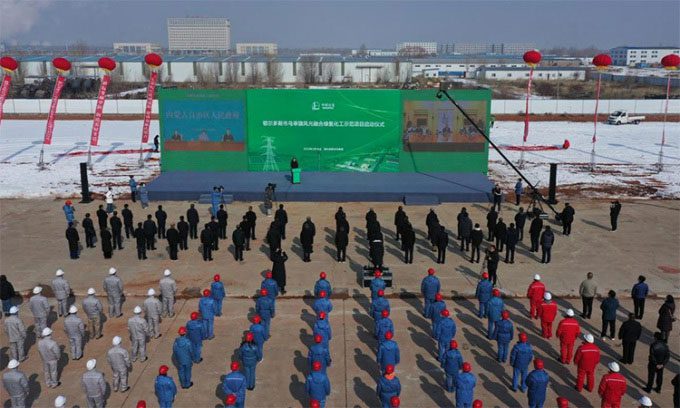A new project aimed at producing hydrogen from wind and solar energy is expected to reduce CO2 emissions by 1.43 million tons annually.

Groundbreaking ceremony for the green hydrogen production project in Ordos, Inner Mongolia, northern China. (Photo: Sinopec/China Daily)
The China Petroleum and Chemical Corporation (Sinopec) announced that the world’s largest green hydrogen production project has commenced in Ordos, Inner Mongolia, northern China, as reported by CGTN on February 18.
Green hydrogen is produced from renewable energy sources such as solar and wind, without emitting CO2. Both of these renewable energy sources are abundant in Ordos. This is Sinopec’s second green hydrogen project after the one in Kuqa, Xinjiang Uygur Autonomous Region, northwestern China. The Kuqa project began in 2021 and is currently 80% complete.
The new project’s activities mainly consist of five areas: wind and solar power generation, electricity conversion and transmission, hydrogen production through water electrolysis, hydrogen storage, and hydrogen transportation. The designed capacity for wind and solar power generation is 450 MW and 270 MW, respectively.
Sinopec stated that once operational, the new plant will produce 30,000 tons of green hydrogen with a storage capacity of 288,000m3. The project is being implemented by Sinopec Star Petroleum, a subsidiary specializing in new energy investments for Sinopec.
Upon completion, the project could reduce approximately 1.43 million tons of CO2 emissions annually, equivalent to planting 825,000 trees, according to Xu Zhendong, the CEO of Sinopec Star’s Inner Mongolia branch.
China is currently the largest hydrogen producer, but most of the hydrogen is produced from coal. By 2025, the country aims to produce 100,000 – 200,000 tons of hydrogen from renewable energy and reduce 1 – 2 million tons of CO2 emissions each year.


















































